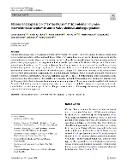Fibrosis and expression of extracellular matrix proteins in human interventricular septum in aortic valve stenosis and regurgitation

Autor
Eckhardt, Adam
Datum vydání
2024Publikováno v
Histochemistry and Cell BiologyRočník / Číslo vydání
161 (5)ISBN / ISSN
ISSN: 0948-6143ISBN / ISSN
eISSN: 1432-119XMetadata
Zobrazit celý záznamKolekce
Tato publikace má vydavatelskou verzi s DOI 10.1007/s00418-024-02268-y
Abstrakt
Valvular heart disease leads to ventricular pressure and/or volume overload. Pressure overload leads to fibrosis, which might regress with its resolution, but the limits and details of this reverse remodeling are not known. To gain more insight into the extent and nature of cardiac fibrosis in valve disease, we analyzed needle biopsies taken from the interventricular septum of patients undergoing surgery for valve replacement focusing on the expression and distribution of major extracellular matrix protein involved in this process. Proteomic analysis performed using mass spectrometry revealed an excellent correlation between the expression of collagen type I and III, but there was little correlation with the immunohistochemical staining performed on sister sections, which included antibodies against collagen I, III, fibronectin, sarcomeric actin, and histochemistry for wheat germ agglutinin. Surprisingly, the immunofluorescence intensity did not correlate significantly with the gold standard for fibrosis quantification, which was performed using Picrosirius Red (PSR) staining, unless multiplexed on the same tissue section. There was also little correlation between the immunohistochemical markers and pressure gradient severity. It appears that at least in humans, the immunohistochemical pattern of fibrosis is not clearly correlated with standard Picrosirius Red staining on sister sections or quantitative proteomic data, possibly due to tissue heterogeneity at microscale, comorbidities, or other patient-specific factors. For precise correlation of different types of staining, multiplexing on the same section is the best approach.
Klíčová slova
Collagen, Fibronectin, Fibrosis, Pressure overload, Valvular heart disease
Trvalý odkaz
https://hdl.handle.net/20.500.14178/2370Licence
Licence pro užití plného textu výsledku: Creative Commons Uveďte původ 4.0 International







